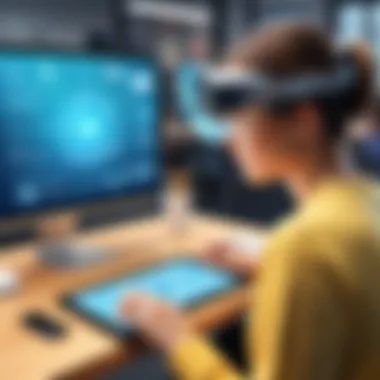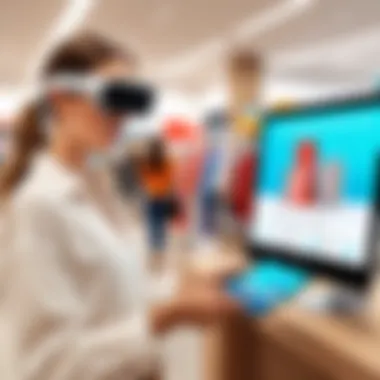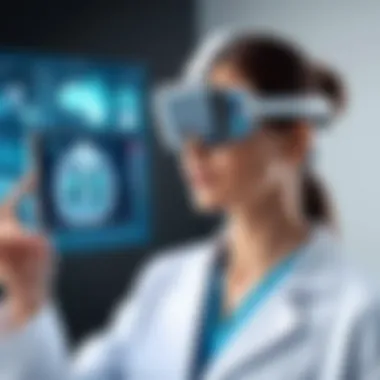Exploring the Future of Augmented Reality Applications


Intro
Augmented Reality (AR) has become a pivotal technology in today's digital landscape. It bridges the gap between the physical world and the digital realm, providing innovative solutions for various industries and users. This guide aims to navigate through the myriad applications of AR, detailing the mechanisms and functionalities that set them apart. By delving into key applications and their respective usage scenarios, this narrative will equip both technology enthusiasts and industry professionals with invaluable insights into AR's potential and its implications in real-world applications.
Understanding AR starts with recognizing its core purpose. At its essence, AR enhances real-world environments through digitally generated content, adding layers of information that transform user experiences. From gaming and education to healthcare and real estate, AR is reshaping how we interact with our surroundings.
This article is structured to explore several dimensions of augmented reality applications, addressing the key points, functionalities, and benefits that define this technological frontier. As we proceed, we will investigate software options available for AR development, required setups, and installation details necessary for seamless integration into various industries.
Software Overview
When exploring augmented reality applications, the software lies at the heart of the experience. It determines how AR content is created, displayed, and interacted with. Understanding the purpose and function of this software is crucial for optimal application use.
Purpose and function of the software
AR software typically serves to overlay digital information onto the user's real-world view. This interaction can range from simple visual cues to complex data visualizations, all designed to enrich the user's experience and provide contextual information. For developers, this software acts as a framework to create immersive experiences, enabling tracking, rendering, and interactivity.
Key features and benefits
Some of the notable features of AR software include:
- Real-time tracking: The ability to detect and respond to physical environments instantly.
- User interactivity: Engaging users through responsive visuals and components.
- Cross-platform compatibility: Supporting a wide variety of devices, making it accessible for more users.
- Data integration: Merging real-time data with AR experiences to provide valuable insights.
The benefits of employing AR applications include:
- Enhanced learning experiences in educational settings.
- Improved decision-making through better data visualization in sectors like healthcare and engineering.
- Innovative marketing campaigns leveraging AR for increased consumer engagement.
- Efficient training processes in corporate environments, eliminating the need for extensive resources.
“AR applications have the potential to revolutionize how we perceive and interact with our environment, making everyday tasks more engaging and informative.”
Installation and Setup
To effectively utilize AR applications, it's essential to follow the appropriate installation and setup procedures. Understanding system requirements ensures that the software performs optimally.
System requirements
Typically, AR software demands certain hardware capabilities to function correctly:
- A compatible smartphone or tablet with a quality camera.
- GPS functionality for location-based services.
- Sufficient processing power to handle real-time rendering and tracking.
Installation process
Installing AR applications generally follows these steps:
- Navigate to the respective app store (Google Play or Apple App Store).
- Search for the desired AR application.
- Select the app and tap the "Install" button.
- Once installed, open the application and follow any on-screen setup instructions.
The complexity of installation may vary based on specific applications and devices. However, understanding these general principles provides a solid foundation for engaging with augmented reality in a meaningful way.
Understanding Augmented Reality
Augmented reality (AR) is an essential topic in today’s rapidly evolving technological landscape. It has applications across various fields, making it important to comprehend its core principles and implications. Understanding AR also allows developers and professionals to create innovative solutions that enhance the user experience. By integrating digital information into the physical world, AR has the potential to transform how people interact with their environment.
This section serves as the foundation for exploring AR applications, shedding light on its significance and the various elements that contribute to its functionality.
Definition and Context


Augmented reality is a technology that superimposes computer-generated images, information, and sensory enhancements onto the real world in real-time. It differs from virtual reality, which fully immerses users in a computer-generated environment. In AR, the user's perception of the real world is altered through digital overlays.
The context surrounding AR includes its roots in computer graphics, optical systems, and mobile computing. In recent years, devices such as smartphones and head-mounted displays have contributed to the widespread adoption of AR. This technology serves diverse industries, from gaming to education, providing interactive experiences that were not possible before.
The Evolution of AR Technology
The journey of augmented reality technology is marked by significant milestones that have propelled its development. Its origins can be traced back to the 1960s when Ivan Sutherland developed the first head-mounted display system. This early model paved the way for later advancements.
The late 1990s saw the rise of AR with projects like the Virtual Fixtures system, which allowed users to manipulate physical objects using digital information. In the following years, progress accelerated with the proliferation of smartphones. In 2009, the launch of AR browser apps like Layar showcased the potential of AR on mobile devices.
Today, AR technology continues to evolve with improved programming frameworks, better hardware, and advancements in computer vision. Solutions like ARKit by Apple and ARCore by Google exemplify the current state of AR development, bringing features like motion tracking and scene understanding to developers.
As we delve deeper into this guide, understanding these foundational elements of AR helps underscore its endless possibilities.
Key Components of Augmented Reality Apps
Understanding the components integral to augmented reality apps is essential. These components collectively dictate the effectiveness and usability of AR experiences. In this section, we will look at hardware requirements and software requirements. Both of these aspects play a crucial role in the development and deployment of successful AR applications.
Hardware Requirements
The hardware requirements for augmented reality applications encompass a range of devices and specifications. Successful AR experiences depend on both the effectiveness of the hardware and how well it can interact with the software. Generally, the primary hardware components include:
- Mobile Devices: Smartphones and tablets are the most common platforms for AR. Devices should have a high-resolution display, a capable processor, and sufficient RAM. For example, the latest iPhone or Android devices are commonly used since they support ARKit and ARCore.
- Sensors: AR apps use various sensors, such as cameras, gyroscopes, accelerometers, and GPS, to function effectively. These sensors aid in locating the device's position in space and understanding the environment.
- Wearable Devices: Devices like smart glasses can provide a more immersive AR experience. Google Glass or Microsoft HoloLens are examples that integrate AR seamlessly into real-world environments.
The choice of hardware directly influences the performance of AR applications. Higher-quality sensors and processing power lead to more realistic and fluid AR interactions. It is essential for developers to evaluate the target audience's device capabilities.
Software Requirements
Software requirements for AR applications are equally significant. These requirements include various development tools and platforms tailored for different operating systems. Notably, the software aspects to consider are:
- Development SDKs: Software Development Kits like Apple’s ARKit for iOS or Google’s ARCore for Android are paramount. These SDKs provide the essential tools needed to create AR experiences ranging from basic overlays to complex, interactive environments.
- Backend Services: Many AR applications require backend support for data processing and storage. Platforms like Firebase or Microsoft Azure can facilitate user management, data storage, and real-time analytics.
- 3D Modeling Tools: Software such as Blender or Autodesk Maya is vital for creating 3D assets integral to the AR experience. Well-designed assets enhance the visual credibility of the application.
The right combination of software tools will significantly enhance development efficiency and overall user experience. It is crucial for developers to stay updated on the latest software trends and tools to leverage the best functionalities available.
"The choice of hardware directly influences the performance of AR applications. Higher-quality sensors and processing power lead to more realistic experiences."
Popular Applications for Creating Augmented Reality
Understanding popular applications for Augmented Reality (AR) is crucial as it provides insight into the tools available for developers and businesses. These applications offer essential features that allow creators to design interactive and immersive experiences. In this section, we will discuss several significant AR platforms, exploring their capabilities and advantages. Knowing these options enables professionals to make informed decisions when choosing the right tools for their AR projects.
ARKit for iOS Development
ARKit is Apple's premier AR development toolkit for iOS devices. This framework provides developers with robust capabilities to build AR experiences seamlessly integrated with the iOS ecosystem. It supports various device sensors and allows for advanced features like motion tracking, ambient light estimation, and plane detection.
One of the main benefits of ARKit is its accessibility. Developers familiar with Swift or Objective-C find it easy to integrate AR functionalities into their applications. Moreover, ARKit benefits from continuous updates from Apple, ensuring the tools remain relevant with the latest hardware improvements. Toolkit also provides features such as:
- Scene understanding for meshing and occlusion detection
- Instant placement of AR objects on flat surfaces
- Collaborative sessions for multi-user experiences
ARCore for Android Development
Google's ARCore serves a similar purpose for Android developers. This platform offers a set of APIs that enables the creation of AR applications across a vast range of devices. Like ARKit, ARCore uses device sensors to experience dynamic and context-aware environments.
ARCore stands out with its open-source approach, allowing developers to engage in customizing their AR applications extensively. Notable features include:


- Motion tracking using the device's IMU
- Environmental understanding, recognizing flat surfaces and surroundings
- Light estimation to achieve realistic rendering
Vuforia: A Cross-Platform Solution
Vuforia is another popular AR platform known for its versatility. It is designed for various platforms, including iOS, Android, and even Windows devices, making it a truly cross-platform solution.
One significant advantage of Vuforia is its extensive database of image targets, enabling developers to create AR experiences that can trigger when specific images are recognized. Vuforia supports tracking of both 2D and 3D objects, giving developers flexibility in designing engaging interactions. Additionally, it includes:
- Cloud recognition for broader target datasets
- Model targets for recognizing 3D objects
- Video and model management to handle digital content easily
Unity with AR Foundation
Unity, a popular game engine, offers an AR Foundation framework that integrates both ARKit and ARCore functionalities into a single development environment. This synergy allows developers to build applications for both iOS and Android without rewriting code for each platform.
One of the standout benefits of using Unity is its rich visual interface and extensive asset store, which offers numerous resources for developers. Furthermore, AR Foundation supports:
- Multi-platform development with fewer complications
- Real-time rendering and graphics capabilities
- Robust community support and documentation
Wikitude: Integrating AR with Web Technologies
Wikitude is an AR development platform focusing on web technologies. It allows developers to create AR experiences that can run in a browser. This capability is significant as it enables broader accessibility, eliminating the need for app installations.
Wikitude supports various modern web standards, giving users the ability to create experiences compatible with any device that can access the web. Developers appreciate features like:
- Easy integration into existing websites
- SDKs for both native and web development
- Support for image recognition and tracking
"The selection of the right AR platform can significantly influence the success of a project. Depending on the requirements and target audience, developers should carefully evaluate these available tools."
This comprehensive review of popular AR applications highlights their key features and benefits. Understanding these platforms helps developers determine which tools best align with their AR vision. As the field of augmented reality continues to evolve, staying informed about the latest offerings is essential for success.
Use Cases of Augmented Reality Applications
Understanding the various use cases for augmented reality (AR) applications is crucial for developers and businesses seeking innovative solutions to real-world problems. These applications can enhance user engagement and productivity across multiple sectors. Various industries are leveraging AR technology to create immersive experiences that improve learning, streamline processes, and foster creativity. Below, we explore specific use cases of AR, highlighting their significance and benefits.
Education and Training
Augmented reality has initiated a revolution in education and training. By integrating digital content into the physical world, AR makes learning more interactive. For instance, platforms like Google Expeditions allow students to explore virtual field trips and view 3D models of complex subjects, making abstract concepts tangible. Furthermore, AR can simulate real-world scenarios for training purposes, such as virtual dissection in biology classes. This engagement often leads to improved retention and understanding.
Retail and E-Commerce
The retail industry has embraced AR to enhance customer experience. Applications like IKEA Place demonstrate this by allowing users to visualize furniture in their homes before making a purchase. This improves decision-making and reduces returns. Retailers using AR can provide customers with personalized experiences, interactive product displays, or virtual try-ons. Such features not only attract customers but also increase sales conversion rates through a more informed buying process.
Healthcare and Medical Training
In healthcare, augmented reality serves as a powerful tool for education and training. Medical students can use AR for anatomy lessons, viewing lifelike models overlayed onto their surroundings. Surgical training can benefit from AR as well, where procedures can be visualized step-by-step. Real surgeons might also use AR glasses like Microsoft HoloLens to overlay critical information during surgeries, enhancing precision and patient safety. The ability to visualize complex systems directly translates to better skill acquisition and improved patient outcomes.
Tourism and Navigation
AR applications can profoundly enhance the travel experience. With tools like Google Maps Live View, tourists gain access to guided navigation overlaid on their real-world surroundings. This feature can show directions with arrows pointing towards the destination. Sites of interest can also provide additional information through AR, enriching a visitor's understanding of their environment. Such applications cater to modern travelers who seek both convenience and immersive engagement during their explorations.
Gaming and Entertainment
Gaming stands as one of the most popular areas for utilizing AR. Titles such as Pokémon GO have demonstrated how AR technologies can blend the digital and physical worlds, prompting players to engage with their surroundings. The intrinsic need for exploration provided by AR taps into user curiosity while also promoting social interaction. Artists and developers continually innovate in this field, expanding gaming possibilities and delivering unique experiences that are not easily replicated in traditional formats.


Design Considerations for AR Applications
Designing robust augmented reality applications requires careful thought. AR enhances the real world with digital elements. Thus, the design must foster intuitive human-computer interaction. Poor user interface or experience can ruin an AR app, making it essential to focus on key design elements.
Focusing on user experience (UX) ensures that users find the application easy and enjoyable to use. A well-designed interface guides users seamlessly. It reduces confusion and enhances engagement. For instance, combining visual elements and sounds can deliver immersive experiences. Furthermore, knowing your audience helps in designing a suitable UX. Different demographics may prefer varied aesthetics and functionalities.
Another aspect is the performance optimization. AR applications process real-time data. They need ample resources to deliver fluid animations and interactions. Lag in performance can lead to user frustration. Thus, developers should consider the hardware capabilities. Certain features like high-quality graphics may not render well on low-end devices. A balance between quality and performance is crucial. It ensures wider accessibility to users while maintaining visual fidelity.
Finally, rigorous testing and debugging are fundamental. Bugs can significantly affect user satisfaction. The testing phase should evaluate usability, performance, and functionality extensively. Using tools like ARKit or ARCore can help developers identify issues. Continuous testing throughout the development cycle leads to a smoother launch, ultimately enhancing the overall effectiveness of the application.
Key Takeaway: Comprehensive understanding of user experience, performance needs, and rigorous testing will greatly improve AR applications.
Each of these design considerations plays a critical role. They help turn ideas into effective AR applications. The development team must continuously iterate on these elements to enhance the final product.
The Future of Augmented Reality Applications
The future of augmented reality applications offers a window into transformative possibilities across numerous industries. As technology continues to advance, the integration of more sophisticated AR features will significantly enhance user experiences and practical applications. This evolution includes improvements in hardware that better support AR use, as well as software development that facilitates richer and more immersive environments. Furthermore, this section highlights essential aspects concerning the surrounding elements, benefits, and considerations regarding forthcoming AR applications.
Technological Advancements on the Horizon
A variety of technological advancements will shape the landscape of augmented reality in the coming years. Key developments are expected in hardware capabilities. Devices like smart glasses and headsets, such as the Microsoft HoloLens and Magic Leap, will likely become more lightweight and accessible. These improvements will pave the way for an increase in user engagement and the prevalence of AR in everyday life.
Additionally, advancements in mobile processing power, particularly within smartphones, will allow more complex AR applications to run seamlessly. The implementation of 5G networks will further enhance AR experiences by reducing latency and improving real-time interactions.
A few future tech trends to watch include:
- Advanced Sensors: Integration of depth sensors and improved camera systems will enhance object recognition.
- Artificial Intelligence: AI algorithms will enable AR applications to learn from user interactions, creating tailored experiences.
- Cloud Computing: Offloading processing to the cloud will allow for more resource-intensive AR applications without overloading device hardware.
By focusing on these advancements, developers can create more sophisticated and user-friendly AR applications that will redefine how we interact with the digital world.
Potential Market Trends
The market for augmented reality applications looks promising and is expected to experience substantial growth over the next decade. Several trends indicate how AR can penetrate various sectors, reshaping existing business models and practices.
One major trend is the increasing adoption of AR in education. Educational institutions recognize its potential to enhance engagement and improve learning outcomes. As more educators utilize AR for interactive lessons, demand for AR platforms tailored to educational needs will rise.
Retail is another area experiencing AR growth. Businesses leverage AR to deliver immersive shopping experiences, allowing customers to visualize products in real-time before making a purchase. Major clothing retailers, for instance, have begun implementing virtual fitting rooms, streamlining the purchasing process and reducing returns.
Moreover, sectors such as healthcare, manufacturing, and tourism are poised to capitalize on AR solutions, making it essential for professionals to stay updated on these trends.
"AR is not just a trend; it’s a paradigm shift that continues to gain momentum, influencing how we communicate, learn, and conduct business."
In summary, as the technology matures, industries need to consider how to adapt and integrate AR into their operations effectively. It will be critical to recognize these future trends and advancements to harness the full potential of augmented reality.
Culmination
The conclusion of this article serves as a reflection on the evolution and impact of augmented reality (AR) applications. Understanding AR’s significance demands consideration of various elements, including its technological foundation, the user experience, and the broader implications across different industries.
Summarizing the Impact of AR Applications
Augmented reality applications have set a transformative path for numerous sectors. They have changed how we interact with information, allowing users to visualize data in their immediate environment. This is particularly evident in education and training, where AR provides immersive learning experiences, making complex concepts easier to grasp.
In retail, AR enriches the shopping experience. Customers can visualize how products will look or fit in their homes before making a purchase. This direct engagement can lead to increased sales, as it reduces uncertainty in consumers' buying decisions.
In healthcare, AR is revolutionizing medical training and procedure simulations. Surgeons can practice in lifelike environments, honing their skills with real-time feedback without risks involved.
a.
- Accessibility: The ease of use found in many AR applications has democratized access to complex training and educational resources.
- Engagement: Utilizing AR creates an interactive platform keeping users engaged and enhancing retention of information.
The influence of augmented reality is undeniable. As technology continues to advance, the applications of AR will likely expand, further influencing how we work, learn, and interact. The importance of these applications cannot be overstated. For developers and professionals in the IT field, understanding AR's potential is crucial for leveraging its capabilities in the future.



